Global Temperature Sensing for an Operating Power Transformer Based on Raman Scattering
Abstract
1. Introduction
2. Detecting Principle
2.1. Principle of the DFOS Temperature Sensor Based on Raman Scattering
2.2. Pricinple of Signal Denoising Based on Gaussian Convolution
3. Fabrication and Platform Setup
3.1. Pre-Experiments
3.2. Manufacture of the DFOS Integrated Coil
3.3. Online Monitoring Platform Setup
4. Detecting Results
4.1. Denoising of the Sensing Fiber
4.2. Detecing Results and Discussion
4.3. Comparison with IEC Models
5. Conclusions
- The distributed fiber optic sensor integrated windings can serve as an effective role in the global sensing of an operating power transformer with a temperature accuracy of ±0.2 °C and spatial accuracy of 0.8 m (one turn of the windings).
- The temperature sensing error along one continuous optical fiber is highly consistent with the normal distribution, which indicates that the noises can be greatly suppressed through the Gaussian convolution and hence, the detecting accuracy can be further improved.
- This work is the first to reveal the global internal temperature distribution of an operating power transformer and the detailed thermal information will serve as an important reference for the relevant scholars, especially for the manufacturers.
- The actual temperature distribution of both the HV and LV windings exhibits a decline tendency in the top area of the winding, which means that the real location of hotspot should be much lower than the traditional cognition (which believes it always appears at the winding top). In addition, 90% of the winding height is recommended as the precise hotspot location in this paper according to the real detected data. Further extra protection is needed in this region, especially in thermal and insulation aspects.
Author Contributions
Funding
Conflicts of Interest
References
- Arabul, A.Y.; Senol, I. Development of a hot-spot temperature calculation method for the loss of life estimation of an ONAN distribution transformer. Electr. Eng. 2018, 100, 1651–1659. [Google Scholar] [CrossRef]
- Santisteban, A.; Delgado, F.; Ortiz, A.; Fernandez, I.; Renedo, C.J.; Ortiz, F. Numerical analysis of the hot-spot temperature of a power transformer with alternative dielectric liquids. IEEE Trans. Dielectr. Electr. Insul. 2017, 24, 3226–3235. [Google Scholar] [CrossRef]
- Islam, M.M.; Lee, G.; Hettiwatte, S.N.; Williams, K. Calculating a Health Index for Power Transformers Using a Subsystem-Based GRNN Approach. IEEE Trans. Power Deliv. 2018, 33, 1903–1912. [Google Scholar] [CrossRef]
- Yadav, D.; Nadir, A.K.; Kapoor, P. Direct Monitoring and Control of Transformer Temperature in Order to Avoid its Breakdown Using FOS. Sens. Transducers J. 2008, 96, 81. [Google Scholar]
- Jia, D.P.; Yao, Z.Y.; Li, C.H. The transformer winding temperature monitoring system based on fiber bragg grating. Int. J. Smart Sens. Intell. Syst. 2015, 8, 538–560. [Google Scholar] [CrossRef]
- Magdaleno-Adame, S.; Olivares-Galvan, J.C.; Penabad-Duran, P.; Escarela-Perez, R.; Lopez-García, I. Fast computation of hot spots temperature due to high current cable leads in power transformers tank walls. Int. Trans. Electr. Energy Syst. 2015, 25, 3374–3383. [Google Scholar] [CrossRef]
- Amoda, O.A.; Tylavsky, D.J.; McCulla, G.A.; Knuth, W.A. Acceptability of Three Transformer Hottest-Spot Temperature Models. IEEE Trans. Power Deliv. 2012, 27, 13–22. [Google Scholar] [CrossRef]
- Wang, L.J.; Zhou, L.J.; Yuan, S.; Wang, J.; Tang, H.L.; Wang, D.Y.; Guo, L. Improved Dynamic Thermal Model With Pre-Physical Modeling for Transformers in ONAN Cooling Mode. IEEE Trans. Power Deliv. 2019, 34, 1442–1450. [Google Scholar]
- Lesieutre, B.C.; Hagman, W.H.; Kirtley, J.L. An improved transformer top oil temperature model for use in an on-line monitoring and diagnostic system. IEEE Trans. Power Deliv. 1997, 12, 249–256. [Google Scholar] [CrossRef]
- Kweon, D.; Koo, K.; Woo, J.; Kim, Y. Hot Spot Temperature for 154 kV Transformer Filled with Mineral Oil and Natural Ester Fluid. IEEE Trans. Dielectr. Electr. Insul. 2012, 19, 1013–1020. [Google Scholar] [CrossRef]
- Gong, R.H.; Ruan, J.J.; Chen, J.Z.; Quan, Y.; Wang, J.; Duan, C.H. Analysis and Experiment of Hot-Spot Temperature Rise of 110 kV Three-Phase Three-Limb Transformer. Energies 2017, 10, 1079. [Google Scholar] [CrossRef]
- Arabul, A.Y.; Arabul, F.K.; Senol, I. Experimental thermal investigation of an ONAN distribution transformer by fiber optic sensors. Electr. Power Syst. Res. 2018, 155, 320–330. [Google Scholar] [CrossRef]
- Liu, G.; Zheng, Z.; Ma, X.; Rong, S.C.; Wu, W.G.; Li, L. Numerical and experimental investigation of temperature distribution for oil-Immersed transformer winding based on dimensionless least-squares and upwind finite element method. IEEE Access 2019, 7, 119110–119120. [Google Scholar] [CrossRef]
- Swift, G.; Molinski, T.S.; Bray, R.; Menzies, R. A fundamental approach to transformer thermal modeling. II. Field verification. IEEE Trans. Power Deliv. 2001, 16, 176–180. [Google Scholar] [CrossRef]
- Susa, D.; Palola, J.; Lehtonen, M.; Hyvarinen, M. Temperature rises in an OFAF transformer at OFAN cooling mode in service. IEEE Trans. Power Deliv. 2005, 20, 2517–2525. [Google Scholar] [CrossRef]
- Susa, D.; Nordman, H. A Simple Model for Calculating Transformer Hot-Spot Temperature. IEEE Trans. Power Deliv. 2009, 24, 1257–1265. [Google Scholar] [CrossRef]
- Jardini, J.A.; Brittes, J.L.P.; Magrini, L.C.; Bini, M.A.; Yasuoka, J. Power transformer temperature evaluation for overloading conditions. IEEE Trans. Power Deliv. 2005, 20, 179–184. [Google Scholar] [CrossRef]
- Ukil, A.; Braendle, H.; Krippner, P. Distributed Temperature Sensing: Review of Technology and Applications. IEEE Sens. J. 2012, 12, 885–892. [Google Scholar] [CrossRef]
- Barrias, A.; Casas, J.R.; Villalba, S. A Review of Distributed Optical Fiber Sensors for Civil Engineering Applications. Sensors 2016, 16, 748. [Google Scholar] [CrossRef]
- Bai, Q.; Wang, Q.L.; Wang, D.; Wang, Y.; Gao, Y.; Zhang, H.J.; Zhang, M.J.; Jin, B.Q. Recent Advances in Brillouin Optical Time Domain Reflectometry. Sensors 2019, 19, 1862. [Google Scholar] [CrossRef]
- Yilmaz, G.; Karlik, S. A Distributed Optical Fiber Sensor for Temperature Detection in Power Cables. Sens. Actuator A-Phys. 2006, 125, 148–155. [Google Scholar] [CrossRef]
- Liu, T.; Sun, W.J.; Kou, H.L.; Yang, Z.N.; Meng, Q.S.; Zheng, Y.Q.; Wang, H.T.; Yang, X.T. Experimental study of leakage monitoring of diaphragm walls based on distributed optical fiber temperature measurement technology. Sensors 2019, 19, 2269. [Google Scholar] [CrossRef] [PubMed]
- Boujia, N.; Schmidt, F.; Chevalier, C.; Siegert, D.; Van Bang, D.P. Distributed optical fiber-based approach for soil-structure interaction. Sensors 2020, 20, 321. [Google Scholar] [CrossRef] [PubMed]
- Gao, S.G.; Liu, Y.P.; Li, H.; Sun, L.; Liu, H.L.; Rao, Q.; Fan, X.Z. Transformer winding deformation detection based on BOTDR and ROTDR. Sensors 2020, 20, 62. [Google Scholar] [CrossRef] [PubMed]
- Hu, T.; Hou, G.Y.; Li, Z.X. The field monitoring experiment of the roof strata movement in coal mining based on DFOS. Sensors 2020, 20, 1318. [Google Scholar] [CrossRef]
- Delepine-Lesoille, S.; Pheron, X.; Bertrand, J.; Pilorget, G.; Hermand, G.; Farhoud, R.; Ouerdane, Y.; Boukenter, A.; Girard, S.; Lablonde, L.; et al. Industrial Qualification Process for Optical Fibers Distributed Strain and Temperature Sensing in Nuclear Waste Repositories. J. Sens. 2012, 2012, 1–9. [Google Scholar] [CrossRef]
- Jensen, C.; Fleming, A. Development of Advanced Instrumentation for Transient Testing. Nucl. Technol. 2019, 205, 1354–1368. [Google Scholar] [CrossRef]
- Dakin, J.P.; Pratt, D.J.; Bibby, G.W.; Ross, J.N. Distributed optical fibre Raman temperature sensor using a semiconductor light source and detector. Electron. Lett. 1985, 21, 569–570. [Google Scholar] [CrossRef]
- Zheltikov, A. Nano-optical dimension of coherent anti—Stokes Raman scattering. Laser Phys. Lett. 2004, 1, 468–472. [Google Scholar] [CrossRef]
- Meng, L.; Jiang, M.; Sui, Q.; Feng, D. Optical-fiber distributed temperature sensor: Design and realization. Optoelectron. Lett. 2008, 4, 415–418. [Google Scholar] [CrossRef]
- Myonghwan, K.; June-Ho, L.; Ja-Yoon, K.; Song, M. A study on internal temperature monitoring system for power transformer using optical fiber Bragg grating sensors. In Proceedings of the 2008 International Symposium on Electrical Insulating Materials (ISEIM 2008), Yokkaichi, Japan, 7–11 September 2008; pp. 163–166. [Google Scholar]
- Liu, Y.; Jiang, S.; Fan, X.; Tian, Y. Effects of degraded optical fiber sheaths on thermal aging characteristics of transformer oil. Appl. Sci. 2018, 8, 1401. [Google Scholar] [CrossRef]
- IEC Guide for Power Transformers-Part 7: Loading Guide for Mineral-Oil-Immersed Power Transformers. In IEC 60076-7-2018; IEC: Geneva, Switzerland, 2018; pp. 1–95.
- IEC Guide for Power Transformers-Part 2: Temperature Rise for Liquid-Immersed Transformers. In IEC 60076-2-2011; IEC: Geneva, Switzerland, 2011; pp. 1–100.
- Taghikhani, M.A.; Gholami, A. Estimation of hottest spot temperature in power transformer windings with oil natural cooling. AJEEE 2009, 6, 11–19. [Google Scholar] [CrossRef]
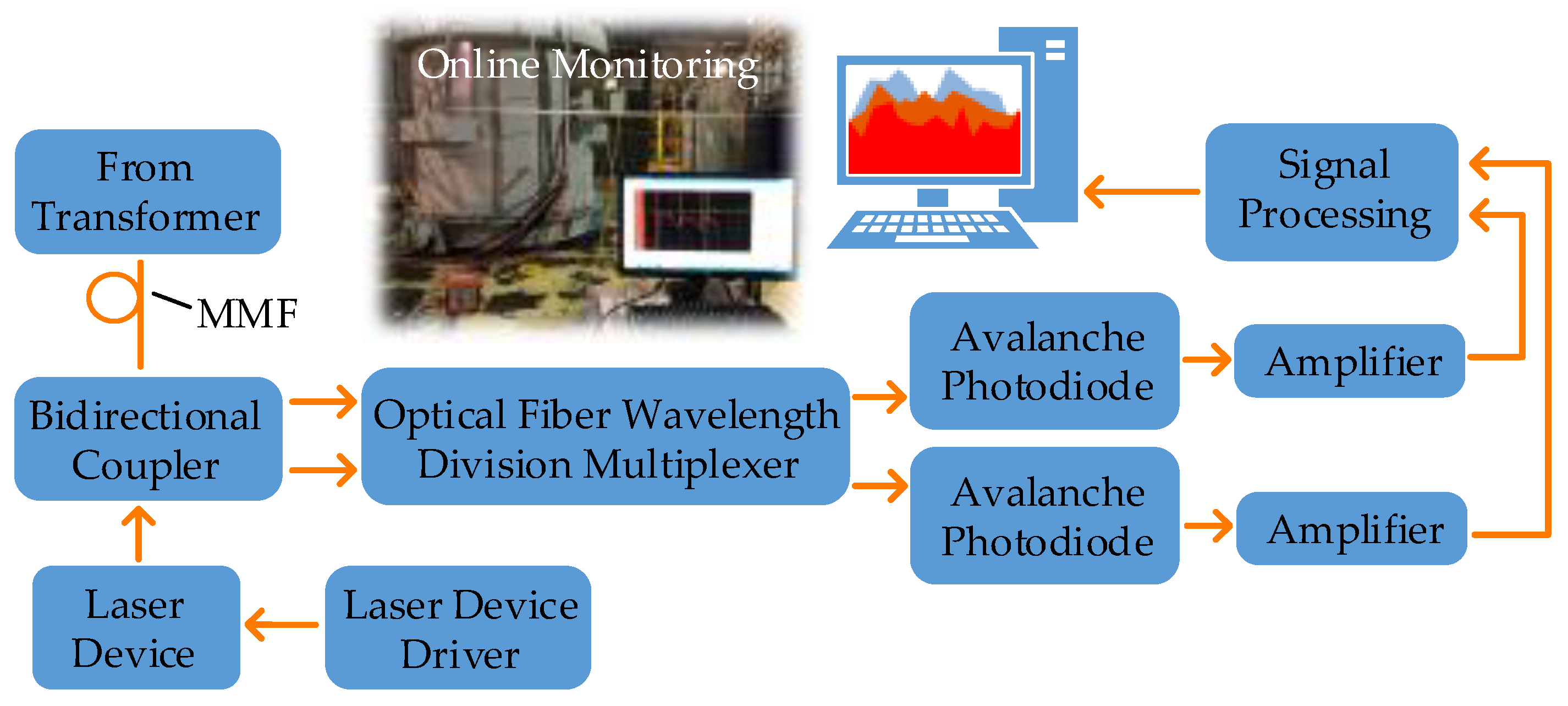
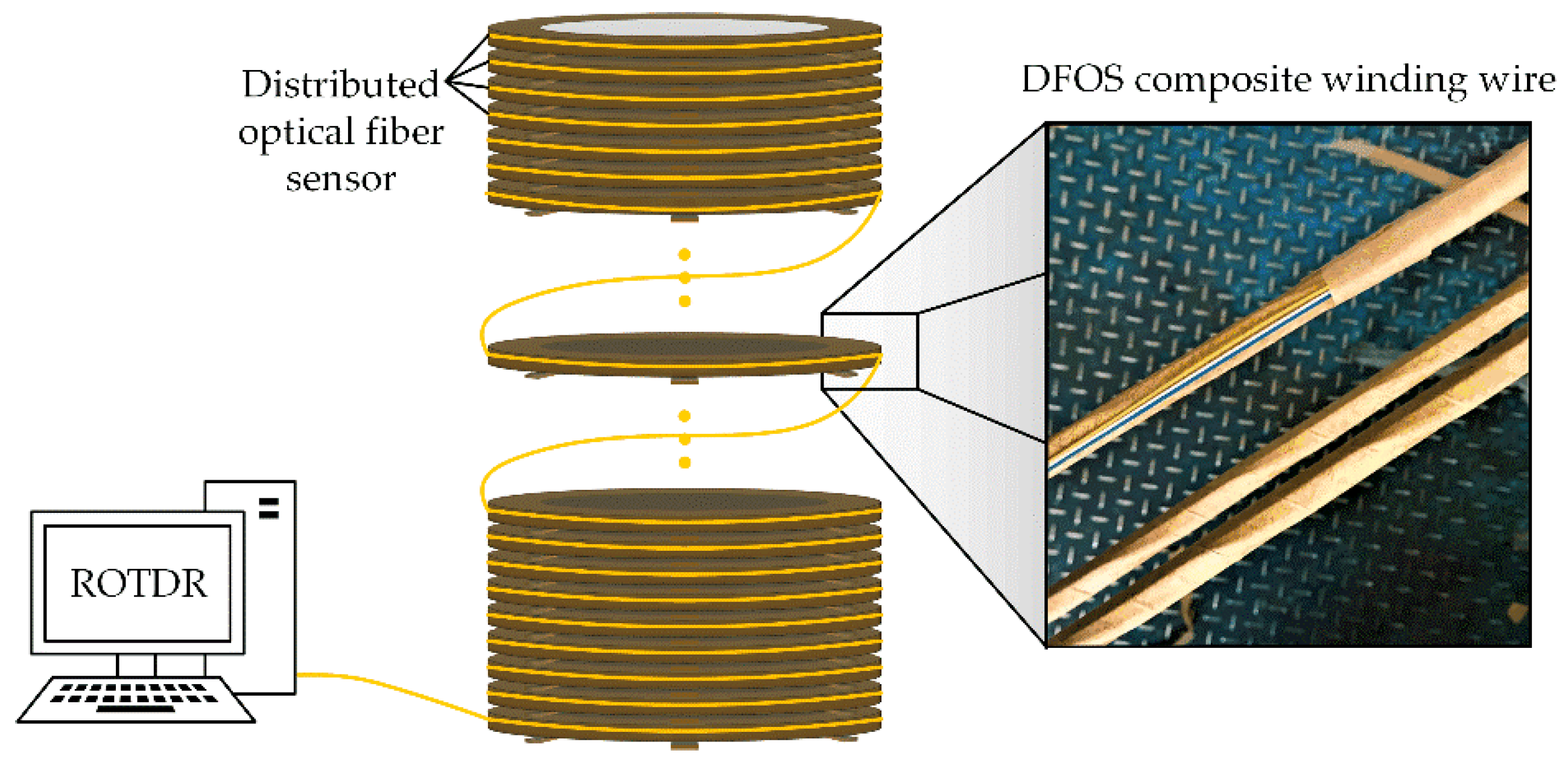
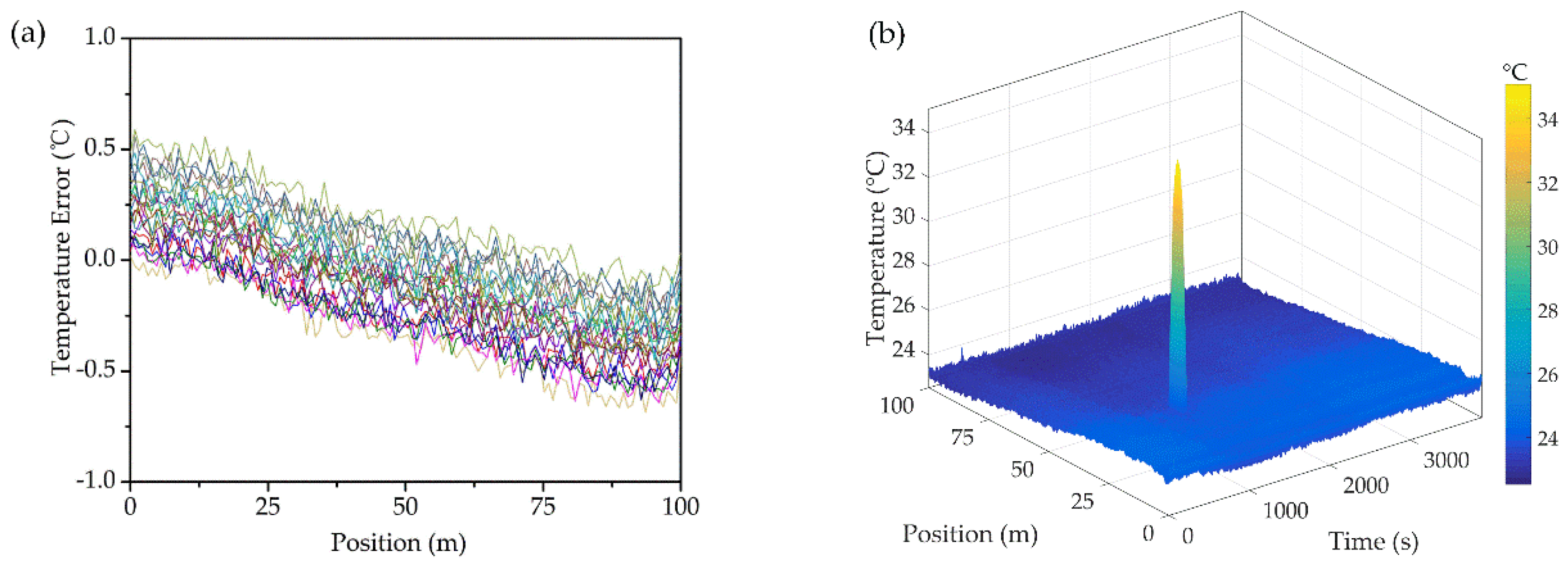
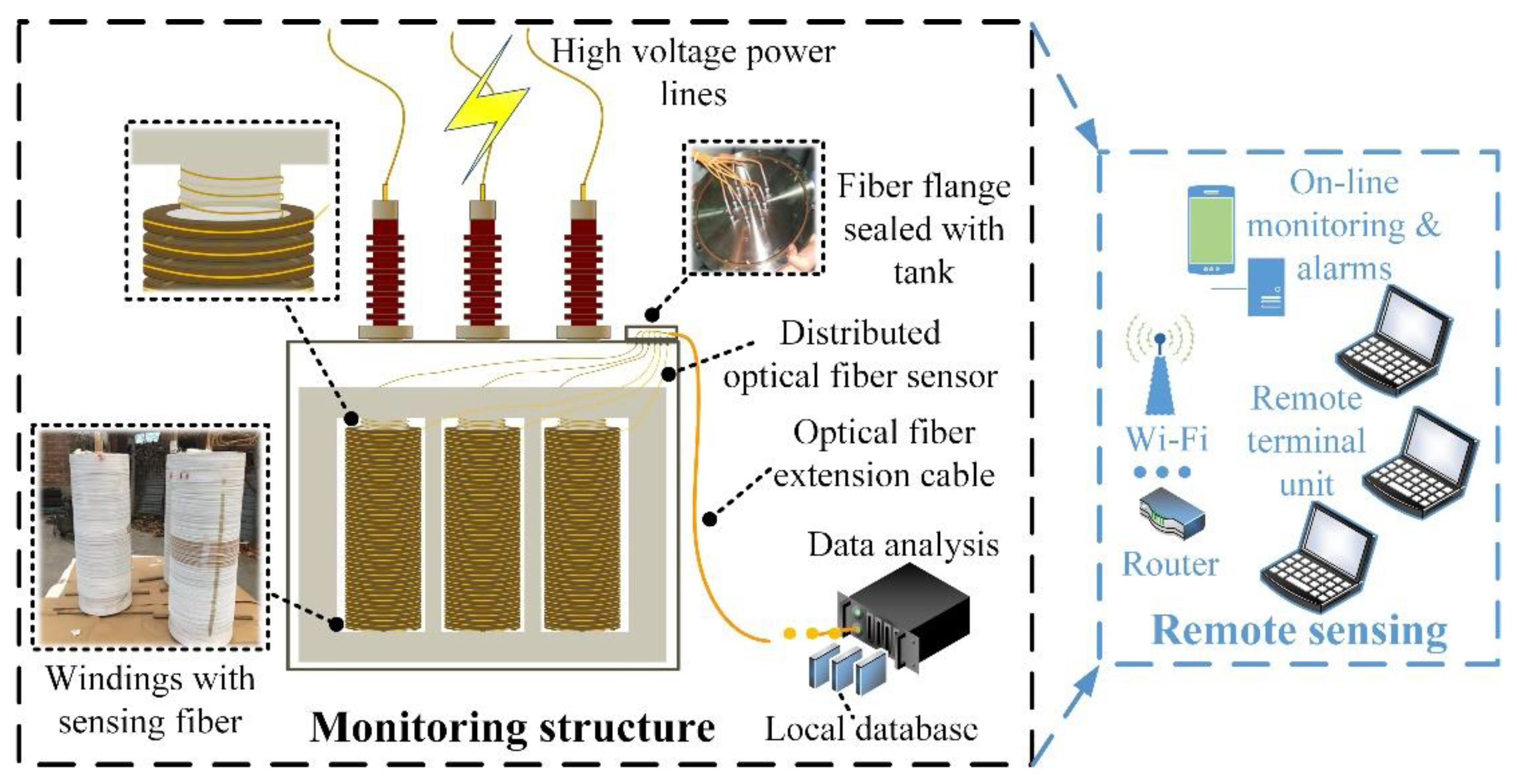
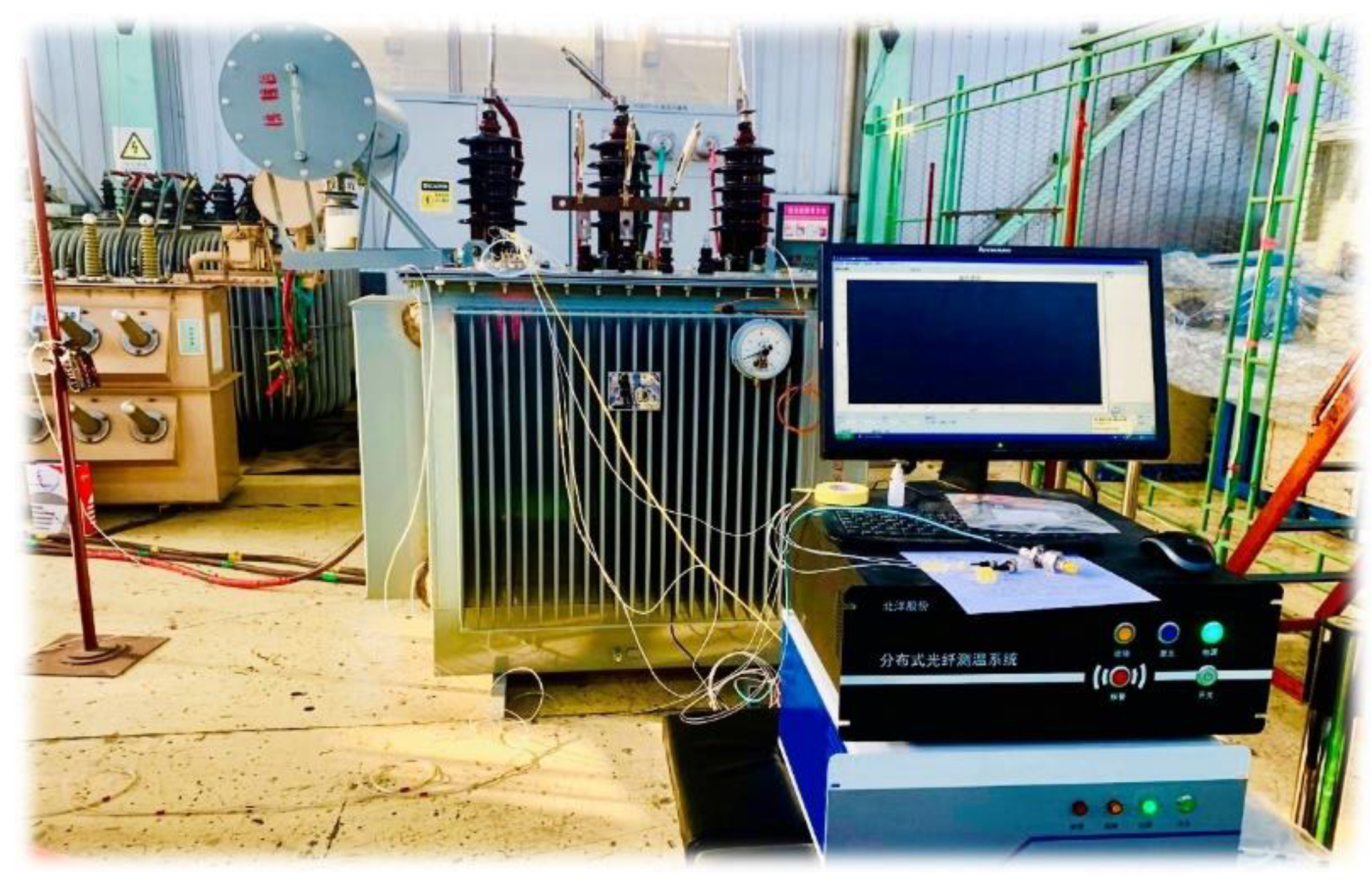
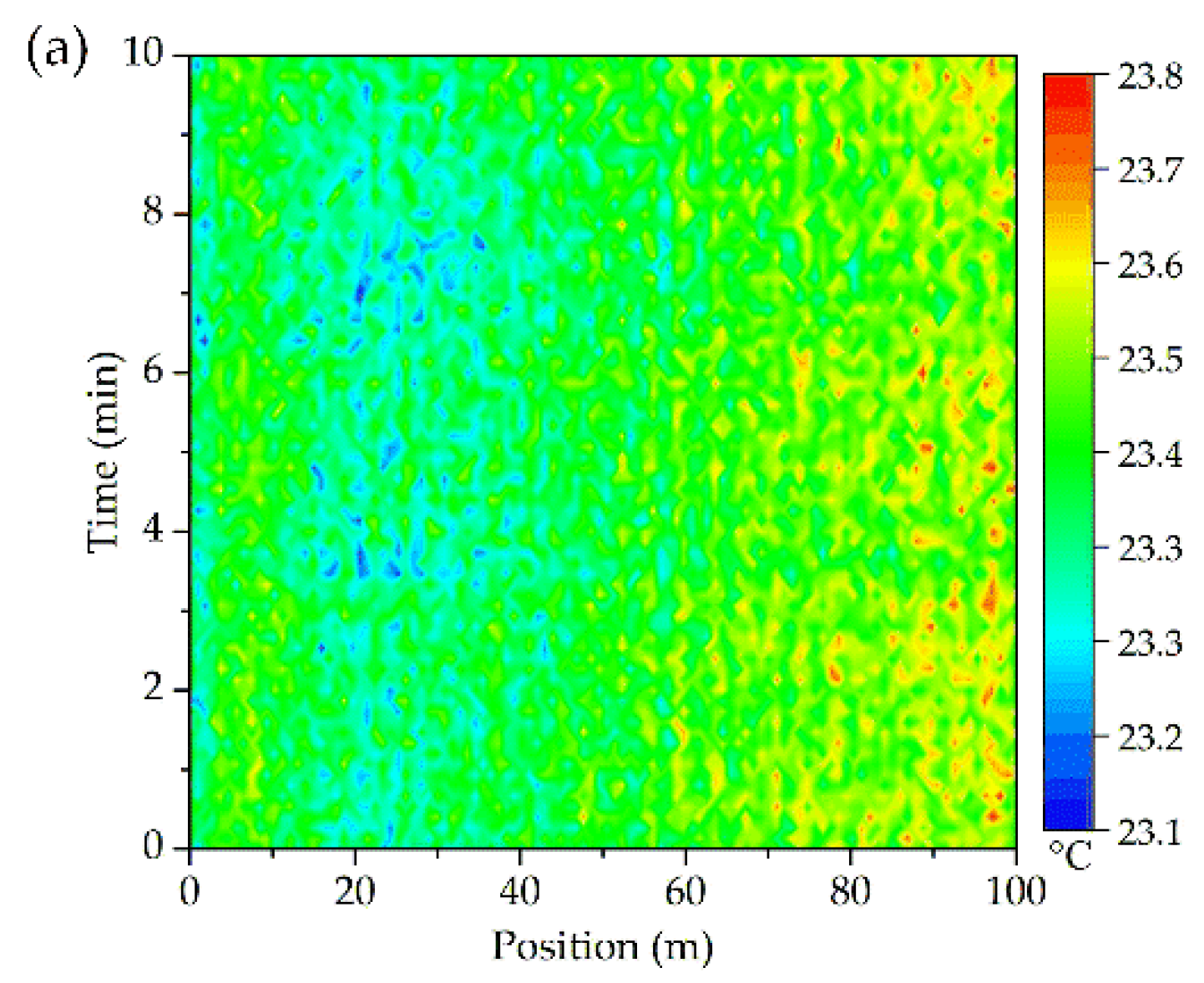
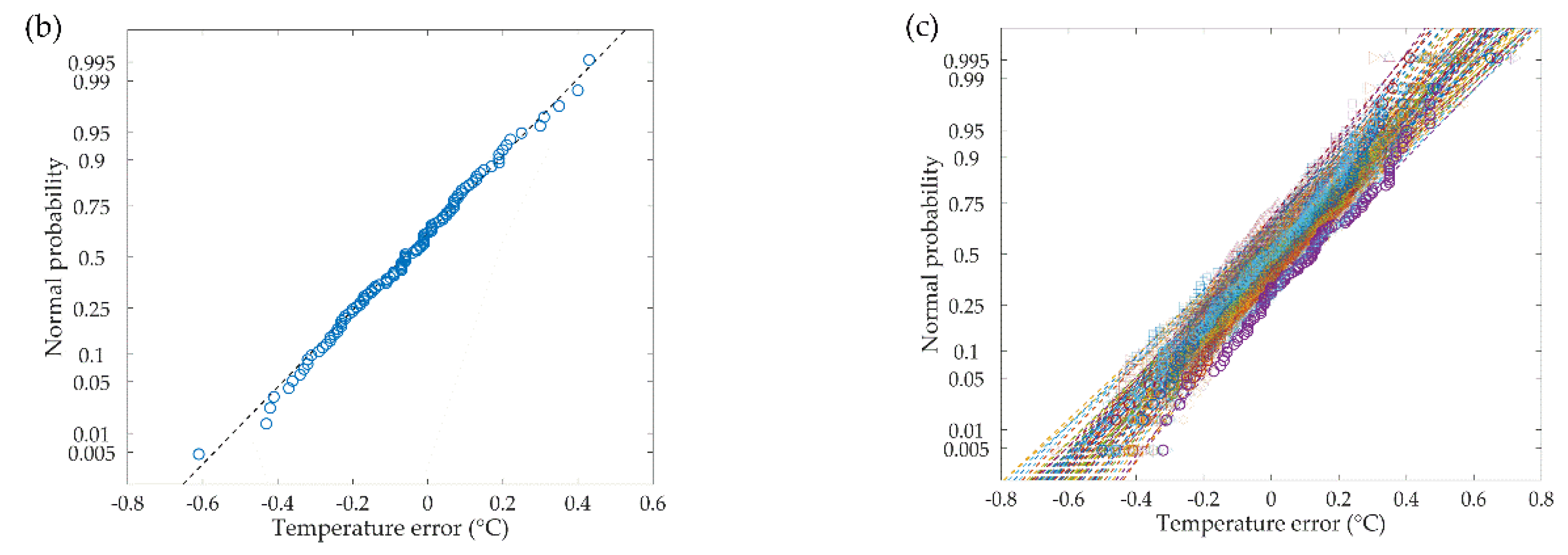

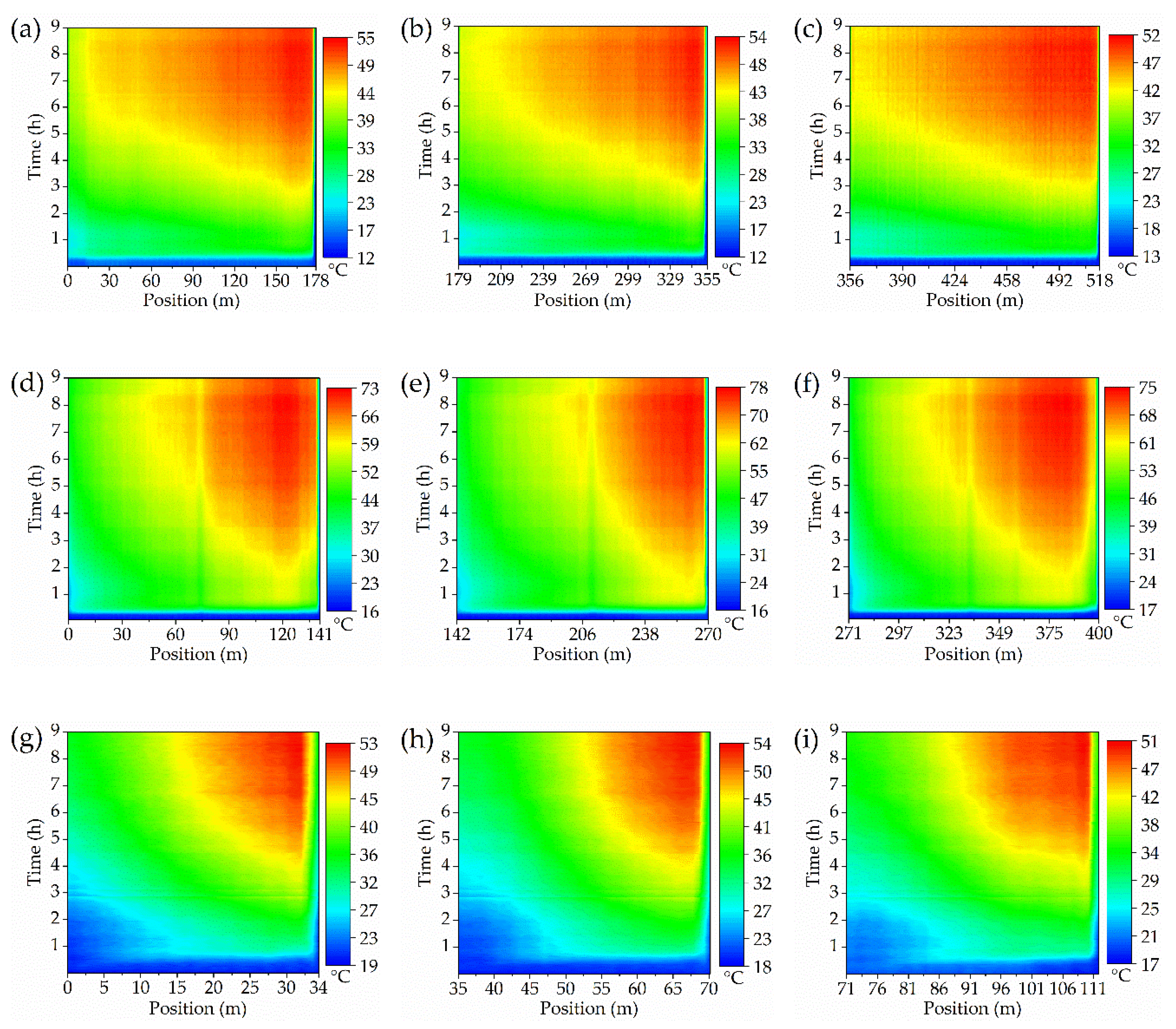
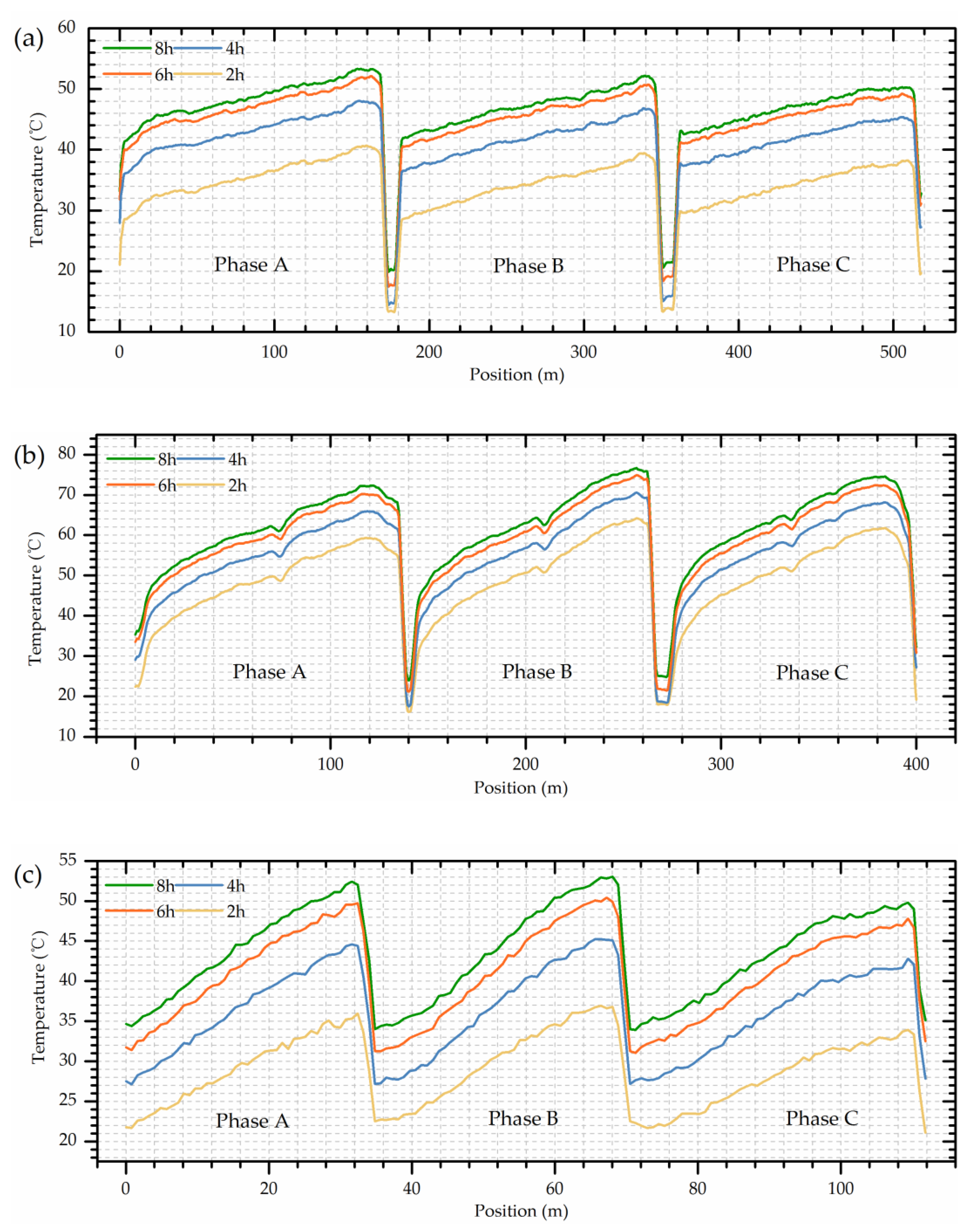
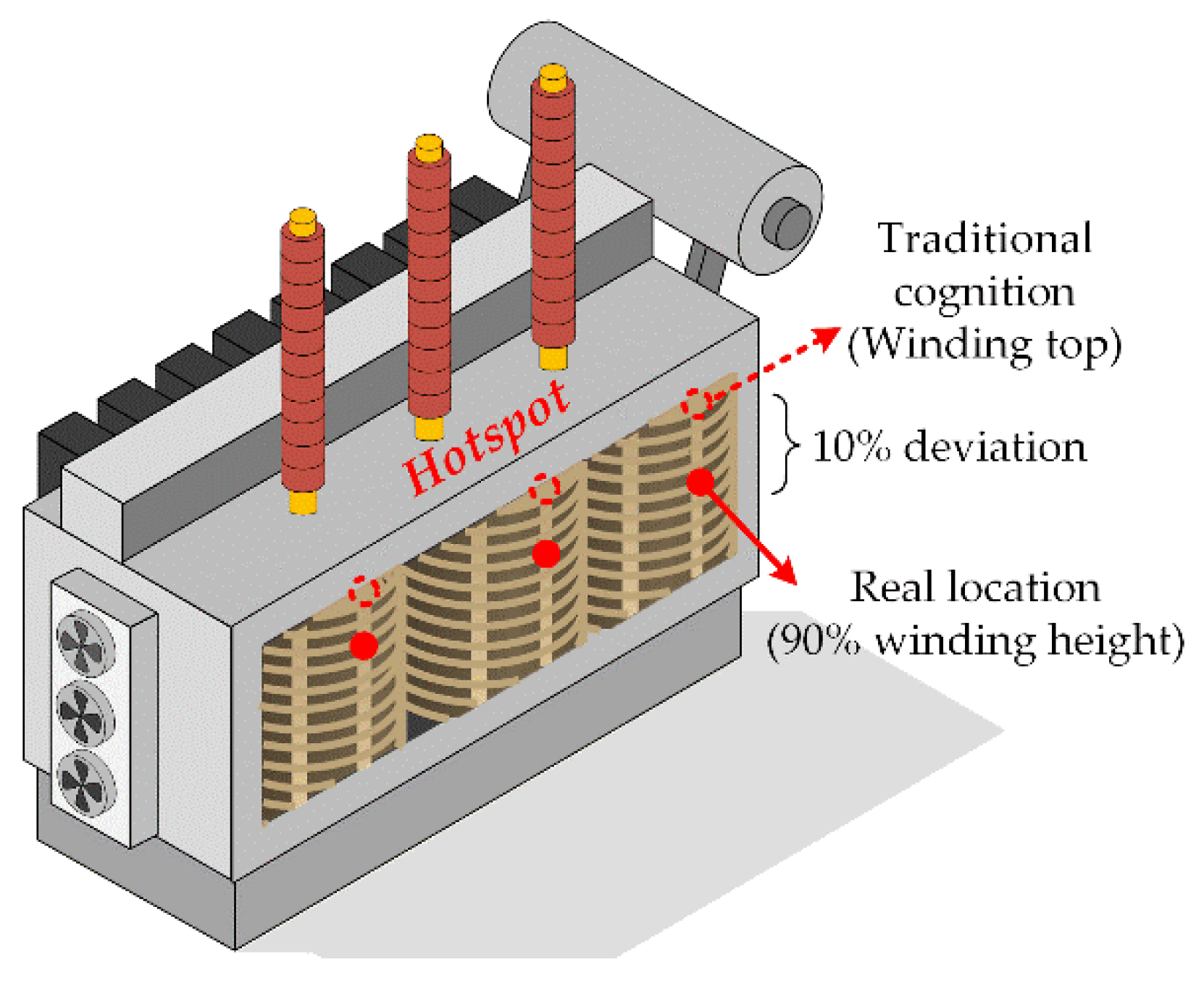
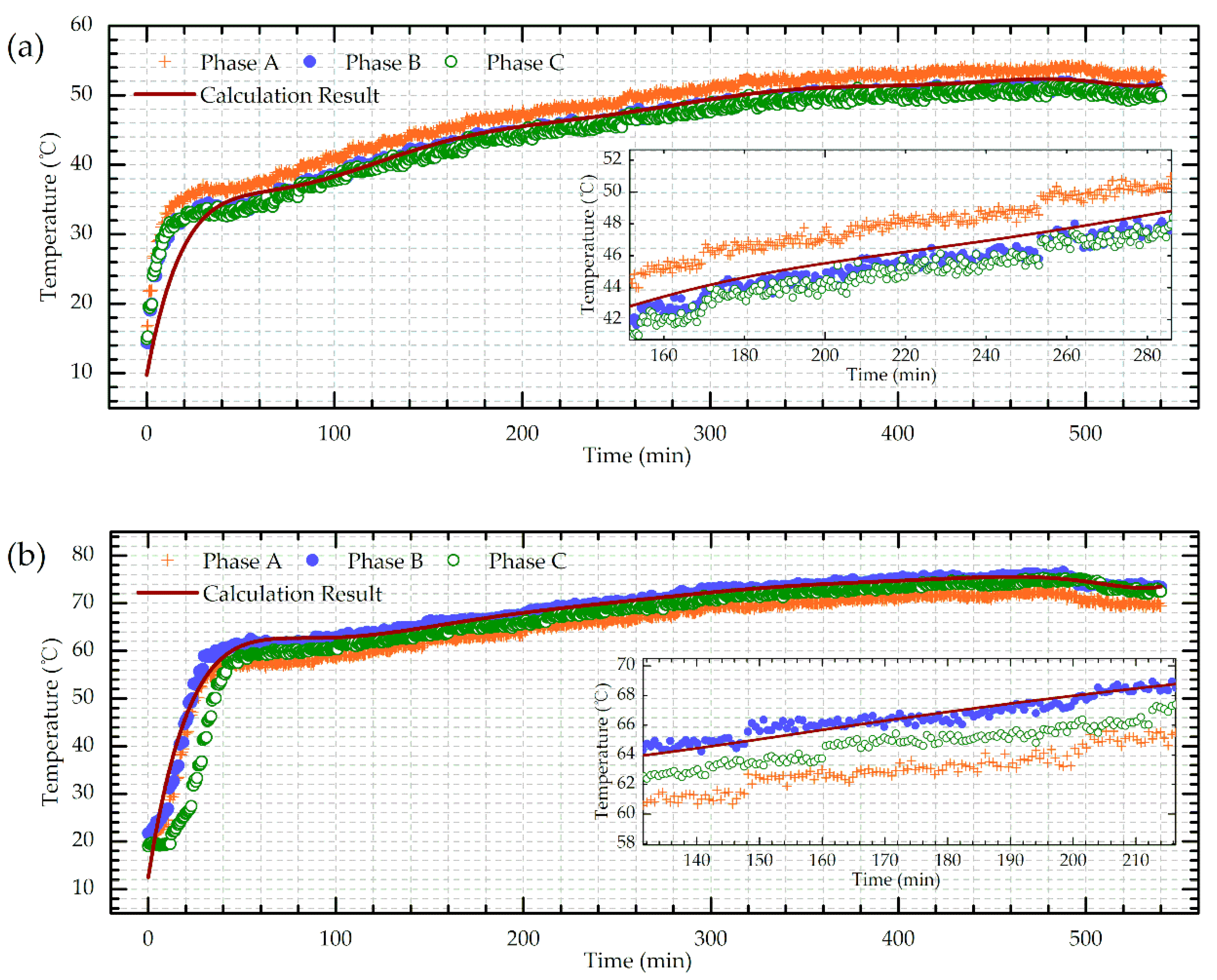
| Classification | Specification |
|---|---|
| Rated voltage/V | 35,000/400 |
| Rated current/A | 3.3/288.7 |
| Rated capacity/kVA | 200, 50 Hz |
| Core type | Shell |
| Temperature rise limit/°C | Top oil: 60 |
| Average winding: 65 | |
| Cooling method | ONAN |
| Classification | Distributed | Point-Type 1 | ||
|---|---|---|---|---|
| DFOS | Fiber Bragg Grating | Fluorescence Fiber | Thermocouple 2 | |
| Range/°C | −30–270 | −40–120 | −30–200 | −100–1300 |
| Accuracy/°C | 1.0 | 1.0 | 1.0 | 0.75% T |
| Resolution/°C | 0.1 | 0.1 | 0.1 | 0.1 |
| Response time/s | 2–10 | 1 | 1 | 1 |
| Sensor type 3/mm | Fiber: Φ 0.9 | Probe: (Φ 8 × L 70) | Probe: (Φ 10 × L 45) | Thermode: (Φ 4) |
| Durability 4/year | 20 | 20 | 20 | 3–5 |
| Cost 5 | Moderate | Low | Low | Very cheap |
| Detecting length/m | 0–2000 | None | None | None |
| Time/h | Phase A | Phase B | Phase C | |||
|---|---|---|---|---|---|---|
| Temp./°C | Pos./% | Temp./°C | Pos./% | Temp./°C | Pos./% | |
| 2 | 40.9 | 89.8 | 39.5 | 89.5 | 38.3 | 91.9 |
| 4 | 48.0 | 88.2 | 46.8 | 90.9 | 45.4 | 91.5 |
| 6 | 52.4 | 91.1 | 50.7 | 91.8 | 49.3 | 91.3 |
| 8 | 53.5 | 91.0 | 52.6 | 91.3 | 50.5 | 91.7 |
| Time/h | Phase A | Phase B | Phase C | |||
|---|---|---|---|---|---|---|
| Temp./°C | Pos./% | Temp./°C | Pos./% | Temp./°C | Pos./% | |
| 2 | 59.4 | 84.4 | 64.3 | 89.5 | 61.9 | 87.5 |
| 4 | 65.9 | 84.9 | 70.6 | 89.7 | 68.3 | 87.7 |
| 6 | 70.3 | 84.1 | 74.9 | 89.6 | 72.4 | 87.6 |
| 8 | 72.5 | 85.4 | 77.5 | 89.7 | 74.6 | 87.7 |
| Time/h | Phase A | Phase B | Phase C | |||
|---|---|---|---|---|---|---|
| Temp./°C | Pos./% | Temp./°C | Pos./% | Temp./°C | Pos./% | |
| 2 | 36.0 | 92.9 | 36.8 | 94.1 | 33.9 | 95.9 |
| 4 | 44.6 | 95.3 | 45.2 | 93.4 | 42.8 | 96.0 |
| 6 | 49.7 | 92.9 | 50.4 | 92.3 | 47.8 | 95.9 |
| 8 | 52.4 | 95.3 | 53.1 | 94.4 | 49.8 | 95.9 |
© 2020 by the authors. Licensee MDPI, Basel, Switzerland. This article is an open access article distributed under the terms and conditions of the Creative Commons Attribution (CC BY) license (http://creativecommons.org/licenses/by/4.0/).
Share and Cite
Liu, Y.; Li, X.; Li, H.; Fan, X. Global Temperature Sensing for an Operating Power Transformer Based on Raman Scattering. Sensors 2020, 20, 4903. https://doi.org/10.3390/s20174903
Liu Y, Li X, Li H, Fan X. Global Temperature Sensing for an Operating Power Transformer Based on Raman Scattering. Sensors. 2020; 20(17):4903. https://doi.org/10.3390/s20174903
Chicago/Turabian StyleLiu, Yunpeng, Xinye Li, Huan Li, and Xiaozhou Fan. 2020. "Global Temperature Sensing for an Operating Power Transformer Based on Raman Scattering" Sensors 20, no. 17: 4903. https://doi.org/10.3390/s20174903
APA StyleLiu, Y., Li, X., Li, H., & Fan, X. (2020). Global Temperature Sensing for an Operating Power Transformer Based on Raman Scattering. Sensors, 20(17), 4903. https://doi.org/10.3390/s20174903






